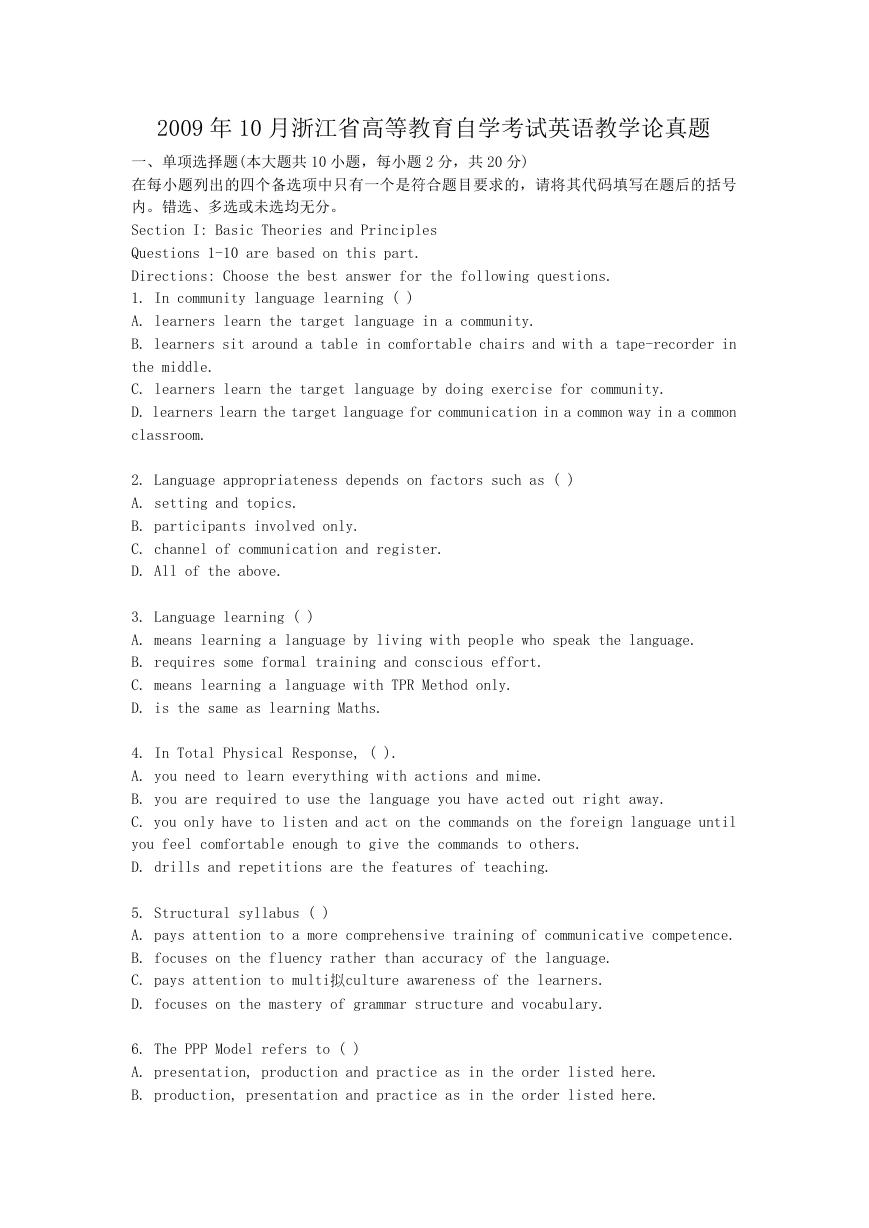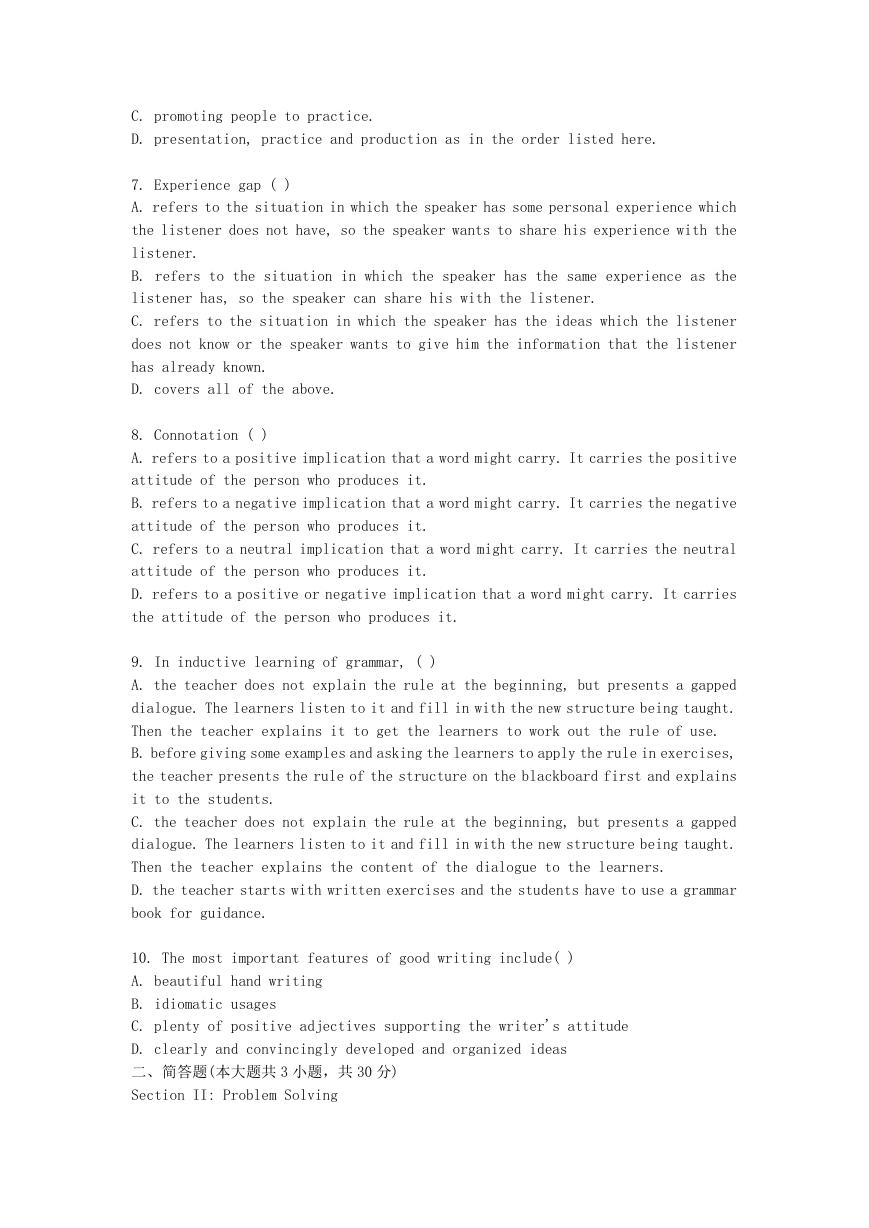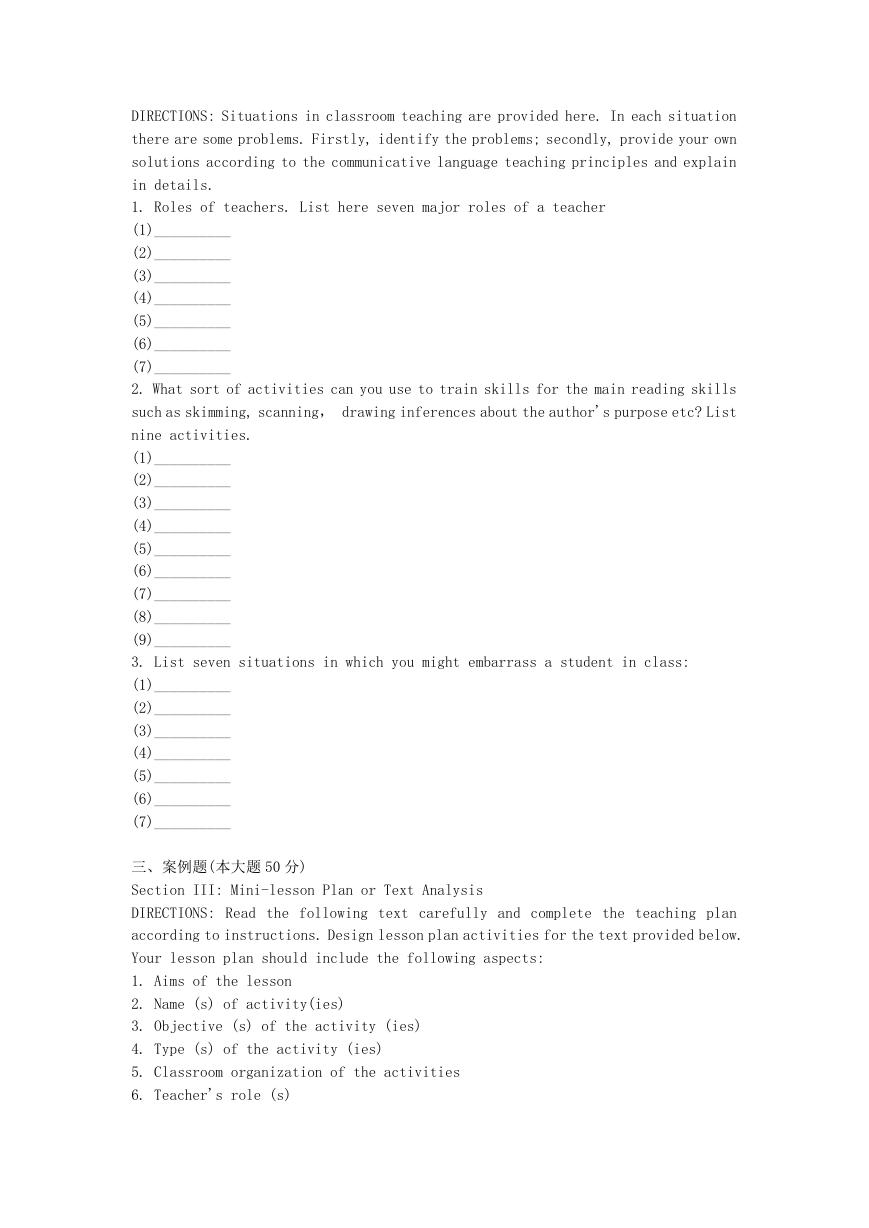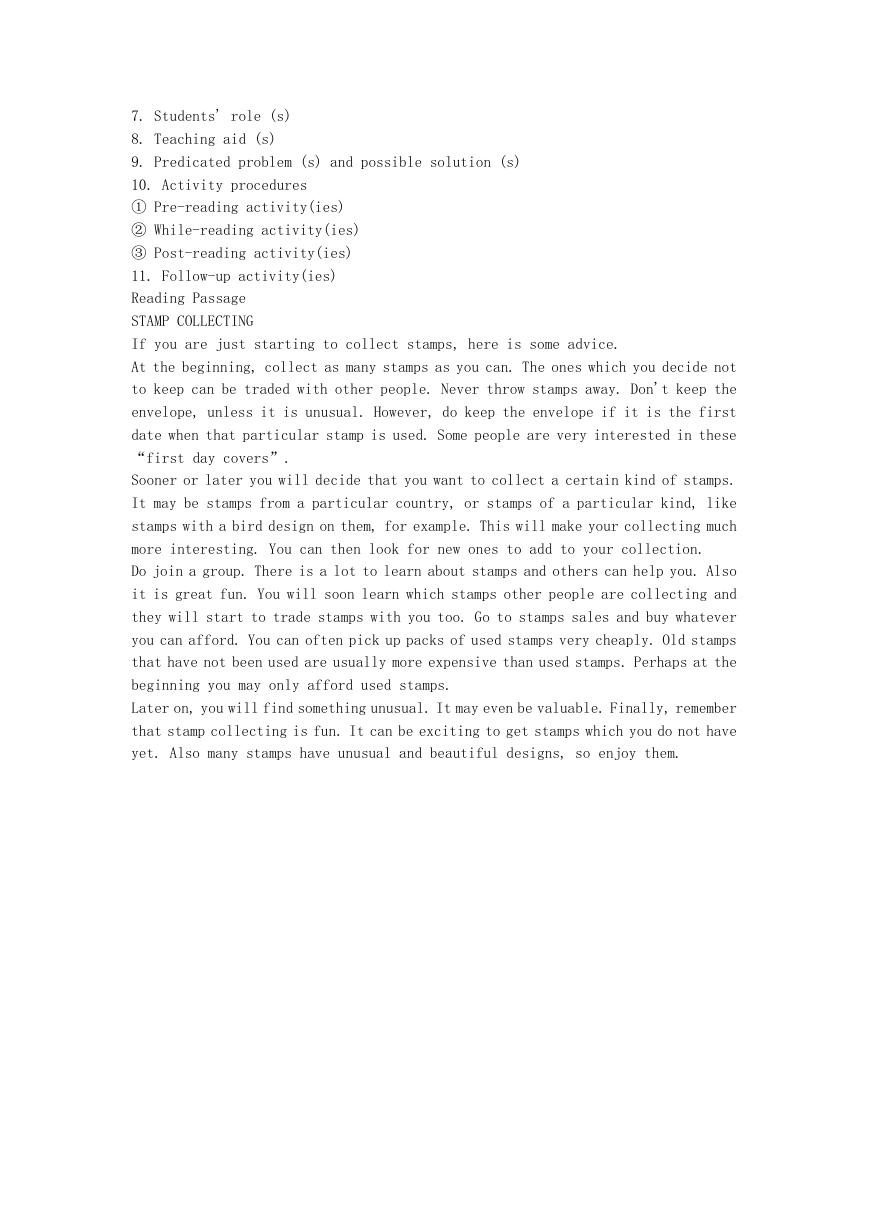2009 年 10 月浙江省高等教育自学考试英语教学论真题
一、单项选择题(本大题共 10 小题,每小题 2 分,共 20 分)
在每小题列出的四个备选项中只有一个是符合题目要求的,请将其代码填写在题后的括号
内。错选、多选或未选均无分。
Section I: Basic Theories and Principles
Questions 1-10 are based on this part.
Directions: Choose the best answer for the following questions.
1. In community language learning ( )
A. learners learn the target language in a community.
B. learners sit around a table in comfortable chairs and with a tape-recorder in
the middle.
C. learners learn the target language by doing exercise for community.
D. learners learn the target language for communication in a common way in a common
classroom.
2. Language appropriateness depends on factors such as ( )
A. setting and topics.
B. participants involved only.
C. channel of communication and register.
D. All of the above.
3. Language learning ( )
A. means learning a language by living with people who speak the language.
B. requires some formal training and conscious effort.
C. means learning a language with TPR Method only.
D. is the same as learning Maths.
4. In Total Physical Response, ( ).
A. you need to learn everything with actions and mime.
B. you are required to use the language you have acted out right away.
C. you only have to listen and act on the commands on the foreign language until
you feel comfortable enough to give the commands to others.
D. drills and repetitions are the features of teaching.
5. Structural syllabus ( )
A. pays attention to a more comprehensive training of communicative competence.
B. focuses on the fluency rather than accuracy of the language.
C. pays attention to multiculture awareness of the learners.
D. focuses on the mastery of grammar structure and vocabulary.
6. The PPP Model refers to ( )
A. presentation, production and practice as in the order listed here.
B. production, presentation and practice as in the order listed here.
�
C. promoting people to practice.
D. presentation, practice and production as in the order listed here.
7. Experience gap ( )
A. refers to the situation in which the speaker has some personal experience which
the listener does not have, so the speaker wants to share his experience with the
listener.
B. refers to the situation in which the speaker has the same experience as the
listener has, so the speaker can share his with the listener.
C. refers to the situation in which the speaker has the ideas which the listener
does not know or the speaker wants to give him the information that the listener
has already known.
D. covers all of the above.
8. Connotation ( )
A. refers to a positive implication that a word might carry. It carries the positive
attitude of the person who produces it.
B. refers to a negative implication that a word might carry. It carries the negative
attitude of the person who produces it.
C. refers to a neutral implication that a word might carry. It carries the neutral
attitude of the person who produces it.
D. refers to a positive or negative implication that a word might carry. It carries
the attitude of the person who produces it.
9. In inductive learning of grammar, ( )
A. the teacher does not explain the rule at the beginning, but presents a gapped
dialogue. The learners listen to it and fill in with the new structure being taught.
Then the teacher explains it to get the learners to work out the rule of use.
B. before giving some examples and asking the learners to apply the rule in exercises,
the teacher presents the rule of the structure on the blackboard first and explains
it to the students.
C. the teacher does not explain the rule at the beginning, but presents a gapped
dialogue. The learners listen to it and fill in with the new structure being taught.
Then the teacher explains the content of the dialogue to the learners.
D. the teacher starts with written exercises and the students have to use a grammar
book for guidance.
10. The most important features of good writing include( )
A. beautiful hand writing
B. idiomatic usages
C. plenty of positive adjectives supporting the writer's attitude
D. clearly and convincingly developed and organized ideas
二、简答题(本大题共 3 小题,共 30 分)
Section II: Problem Solving
�
DIRECTIONS: Situations in classroom teaching are provided here. In each situation
there are some problems. Firstly, identify the problems; secondly, provide your own
solutions according to the communicative language teaching principles and explain
in details.
1. Roles of teachers. List here seven major roles of a teacher
(1)__________
(2)__________
(3)__________
(4)__________
(5)__________
(6)__________
(7)__________
2. What sort of activities can you use to train skills for the main reading skills
such as skimming, scanning, drawing inferences about the author's purpose etc? List
nine activities.
(1)__________
(2)__________
(3)__________
(4)__________
(5)__________
(6)__________
(7)__________
(8)__________
(9)__________
3. List seven situations in which you might embarrass a student in class:
(1)__________
(2)__________
(3)__________
(4)__________
(5)__________
(6)__________
(7)__________
三、案例题(本大题 50 分)
Section III: Mini-lesson Plan or Text Analysis
DIRECTIONS: Read the following text carefully and complete the teaching plan
according to instructions. Design lesson plan activities for the text provided below.
Your lesson plan should include the following aspects:
1. Aims of the lesson
2. Name (s) of activity(ies)
3. Objective (s) of the activity (ies)
4. Type (s) of the activity (ies)
5. Classroom organization of the activities
6. Teacher's role (s)
�
7. Students' role (s)
8. Teaching aid (s)
9. Predicated problem (s) and possible solution (s)
10. Activity procedures
① Pre-reading activity(ies)
② While-reading activity(ies)
③ Post-reading activity(ies)
11. Follow-up activity(ies)
Reading Passage
STAMP COLLECTING
If you are just starting to collect stamps, here is some advice.
At the beginning, collect as many stamps as you can. The ones which you decide not
to keep can be traded with other people. Never throw stamps away. Don't keep the
envelope, unless it is unusual. However, do keep the envelope if it is the first
date when that particular stamp is used. Some people are very interested in these
“first day covers”.
Sooner or later you will decide that you want to collect a certain kind of stamps.
It may be stamps from a particular country, or stamps of a particular kind, like
stamps with a bird design on them, for example. This will make your collecting much
more interesting. You can then look for new ones to add to your collection.
Do join a group. There is a lot to learn about stamps and others can help you. Also
it is great fun. You will soon learn which stamps other people are collecting and
they will start to trade stamps with you too. Go to stamps sales and buy whatever
you can afford. You can often pick up packs of used stamps very cheaply. Old stamps
that have not been used are usually more expensive than used stamps. Perhaps at the
beginning you may only afford used stamps.
Later on, you will find something unusual. It may even be valuable. Finally, remember
that stamp collecting is fun. It can be exciting to get stamps which you do not have
yet. Also many stamps have unusual and beautiful designs, so enjoy them.
�








 2023年江西萍乡中考道德与法治真题及答案.doc
2023年江西萍乡中考道德与法治真题及答案.doc 2012年重庆南川中考生物真题及答案.doc
2012年重庆南川中考生物真题及答案.doc 2013年江西师范大学地理学综合及文艺理论基础考研真题.doc
2013年江西师范大学地理学综合及文艺理论基础考研真题.doc 2020年四川甘孜小升初语文真题及答案I卷.doc
2020年四川甘孜小升初语文真题及答案I卷.doc 2020年注册岩土工程师专业基础考试真题及答案.doc
2020年注册岩土工程师专业基础考试真题及答案.doc 2023-2024学年福建省厦门市九年级上学期数学月考试题及答案.doc
2023-2024学年福建省厦门市九年级上学期数学月考试题及答案.doc 2021-2022学年辽宁省沈阳市大东区九年级上学期语文期末试题及答案.doc
2021-2022学年辽宁省沈阳市大东区九年级上学期语文期末试题及答案.doc 2022-2023学年北京东城区初三第一学期物理期末试卷及答案.doc
2022-2023学年北京东城区初三第一学期物理期末试卷及答案.doc 2018上半年江西教师资格初中地理学科知识与教学能力真题及答案.doc
2018上半年江西教师资格初中地理学科知识与教学能力真题及答案.doc 2012年河北国家公务员申论考试真题及答案-省级.doc
2012年河北国家公务员申论考试真题及答案-省级.doc 2020-2021学年江苏省扬州市江都区邵樊片九年级上学期数学第一次质量检测试题及答案.doc
2020-2021学年江苏省扬州市江都区邵樊片九年级上学期数学第一次质量检测试题及答案.doc 2022下半年黑龙江教师资格证中学综合素质真题及答案.doc
2022下半年黑龙江教师资格证中学综合素质真题及答案.doc